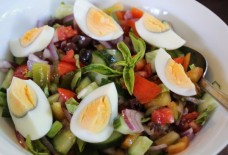What’s Wrong With This Picture?
The Institut des Cultures d’Islam is presently comprised of two buildings located in the French capital’s densely populated Goutte d’Or neighborhood, many of whose residents have roots in the Maghreb and sub-Saharan Africa.
Run by the City of Paris, the ambiguously named cultural center took 10 years to get off the ground. The City was both looking to alleviate the need for more mosques – the center houses a mosque, run by the Grand Mosque of Paris – and to showcase contemporary artwork linked to the greater Middle East.
“We don’t ask that [the artists] be believers, but they can be of Muslim culture, or else artists who are not Muslim but are interested in the cultures of Islam,” ICI president Jamel Oubechou told Le Monde several years ago. “Or artists who are Muslim or from Muslim cultures who live in non-Muslim countries.”
While cultural centers are generally given the green light in France and the additional mosque took some pressure off the city, the Institute’s chosen name enraged certain politicians, who felt it was a poor choice in this staunchly secular country.
ICI is now hosting “Cherchez L’erreur” (What’s wrong with this picture), an exhibition of work by leading female artists from the Arab world and Iran.
The show opened the week after the deadly attacks on the Charlie Hebdo newspaper and the kosher supermarket, and the killing of a police officer.
So social tension and tragedy provided the backdrop for “Cherchez L’erreur.” The show’s opening evening was taken over by representatives from the Socialist-run Paris municipality, anxious to reinforce the need for diversity, tolerance and cultural understanding, representing a united front against the rising far-right and openly Islamophobic National Front party.
“Cherchez L’erreur” is the project of Franco-Tunisian curator and author Michket Krifa – who recently directed the photography festival in Bamako, Mali, and co-edited the 2011 book “Arab Photography Now.”
Affected by last summer’s bloody events in Gaza, Syria and Iraq, Krifa was at a loss as to what to do. “We’re all so impotent, faced with what’s happening in the Middle East,” she said. “People rose up for a better life and for more rights and now it’s just total chaos.
“Women, in a sense, are the guardians of the temple that is daily life. Men go off to war and the women try to keep a routine. They have an eye for detail and intimacy.”
The exhibition’s title refers to what she hopes is obvious: “War and instruments of war are what’s wrong with the picture. It’s daily life that is the norm.”
The show takes place on two floors of ICI’s main building and the ground floor of a second building nearby. Aside from the sculptures of Morocco-based Franco-Algerian artist Zoulikha Bouabdellah, the work is photographic, including a few short films and the widely viewed video of Palestinian poet Rafeef Ziadah’s 2011 performance “We teach life, Sir.”
While the artists were aware of the Paris events, it’s not surprising that they did not feel their work was related to them.
East-Jerusalem-based photographer Tanya Habjouqa is showing her ongoing project “Occupied Pleasures,” in which she explores the notion of pleasure in the occupied West Bank and Gaza.
“For me, the horrors of what happened in Paris do not have any relation to the exhibit, [which, however,] “shows humanity under strife,” Habjouqa said. “That is what is needed in times such as the violent events that unfolded with Charlie Hebdo. This terrorism is something that we are well aware of in the Middle East.”
To Habjouqa, whose photographs are at times surreal, at other times joyful, “this exhibit is a reminder” and a tribute to humanity and humor in the face of a region she feels “has been reduced to stereotypes.
Source: www.dailystar.com.lb


